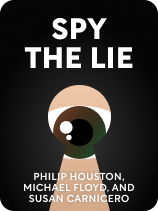

This article is an excerpt from the Shortform book guide to "Spy the Lie" by Philip Houston, Michael Floyd, and Susan Carnicero. Shortform has the world's best summaries and analyses of books you should be reading.
Like this article? Sign up for a free trial here.
Does mixing truth with lies make you seem less guilty? How do people cover up lies with partial truths?
Mixing truth with lies is a common way people get away with deception. By learning how including partial truths can hide a lie, you can better understand how to see through deception.
Keep reading to see how partial truths can hide a lie.
When Truth Mixes with Lies
When it comes to spotting deception, many people think they should look for fabrications: false statements, which can be easy to notice because they conflict with known facts. In reality, mixing truth with lies is very common—instead of making direct fabrications, a deceiver will carefully speak in a way that adds no new information to a conversation, and therefore can’t obviously conflict with the truth. This makes their deception more difficult to notice. (Shortform note: Studies underscore this point on the difficulty of detecting deception—most people do a poor job of it because they’re focused on the question of whether someone is lying rather than looking for subtle signs of insincerity.)
There are two main ways that people hide deception within truth: manipulation and omission. Let’s explore why each is tricky to pick up on.
Manipulation
Manipulation in the context of deception means making true statements to make you seem more trustworthy. Manipulation exploits the common bias that people are honest—if someone reminds you why you should trust them, you’ll often go along with it. Manipulation is especially effective in situations where it doesn’t make sense for someone to have done something wrong.
For example, if a wealthy friend steals a small amount of money from you, he may manipulate you by pointing out that he has plenty of money and that it would be stupid to jeopardize your friendship over such a small amount.
(Shortform note: While manipulation is hard to spot, there are some telltale signs. Some psychologists say that good communication adheres to four principles: relevance, quantity (appropriate amount of information), quality (true information supported by reasoning or evidence), and manner (unambiguous presentation). Someone who’s manipulating you will likely be missing at least one of these elements from their communication. For example, their statements might be irrelevant to the conversation, they might leave out important details, they might make unsupported claims, or they might use wordplay to imply information without outright saying it.)
Omission
Omission in the context of deception means leaving out important information from an otherwise true statement. Most people feel uncomfortable with fabricating false statements—it’s psychologically easier to believe that omitting vital details means they aren’t really lying. Unlike a manipulator, someone who deceives via omission doesn’t offer an argument as to why you should consider them innocent.
For example, an omitter, who stole a watch that morning, is asked if she stole it. She replies, “Buzz told me about that after I clocked in.” By giving a response that omits the information you’re looking for (yes or no), she avoids outright lying to you and implies—rather than argues—her role as an innocent bystander.
(Shortform note: Research supports the idea that most people are uncomfortable with telling lies—and suggests that this is the case no matter the reason for lying. One study concluded that its participants felt just as uncomfortable telling a lie with selfish motives as they were telling a lie to benefit the person they lied to.)
| Why Innocent People Omit Information—and Why It Backfires One factor that complicates how omission hides deception is that omission isn’t limited to guilty people—research shows that innocent people often omit some of the truth when questioned, which makes them seem guilty. In one study about how often innocent people lie to investigators, some participants were told to retrieve an envelope full of money from a cabinet that also contained a wallet full of money and be truthful during later questioning. Other participants were told to steal the wallet and lie during later questioning. A student investigator later approached each participant and explained that the wallet in the cabinet had gone missing and asked if the participant had anything to do with it. In their responses, many of the envelope-taking participants omitted the fact that they’d taken the envelope from the cabinet because—they thought it would make them seem more suspicious, even though they knew they were innocent. Their omission backfired, however—the student investigator’s ratings showed that the innocent (but omissive) participants were just as likely to be labeled guilty as the wallet-stealing participants. |

———End of Preview———
Like what you just read? Read the rest of the world's best book summary and analysis of Philip Houston, Michael Floyd, and Susan Carnicero's "Spy the Lie" at Shortform.
Here's what you'll find in our full Spy the Lie summary:
- Why your brain is wired to believe others
- How you can learn to read body language like a spy
- The three traits of effective lie-detecting questions






